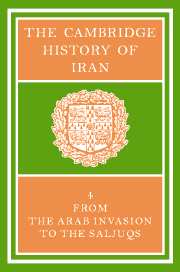Book contents
- Frontmatter
- 1 THE ARAB CONQUEST OF IRAN AND ITS AFTERMATH
- 2 THE ‘ABBĀSID CALIPHATE IN IRAN
- 3 THE ṬĀHIRIDS AND ṢAFFĀRIDS
- 4 The SĀMĀNIDS
- 5 THE EARLY GHAZNAVIDS
- 6 THE MINOR DYNASTIES OF NORTHERN IRAN
- 7 IRAN UNDER THE BŪYIDS
- 8 TRIBES, CITIES AND SOCIAL ORGANIZATION
- 9 THE VISUAL ARTS
- 10 NUMISMATICS
- 11 THE EXACT SCIENCES
- 12 LIFE SCIENCES, ALCHEMY AND MEDICINE
- 13(a) PHILOSOPHY AND COSMOLOGY
- (b) SŪFISM
- 14 THE RELIGIOUS SCIENCES
- 15 SECTS AND HERESIES
- 16 NĀSIR-I KHUSRAU AND IRANIAN ISMĀ‘ĪLĪSM
- 17 ZOROASTRIAN LITERATURE AFTER THE MUSLIM CONQUEST
- 18 ARABIC LITERATURE IN IRAN
- 19 THE RISE OF THE NEW PERSIAN LANGUAGE
- 20 (a) THE “RUBĀ'Ī” IN EARLY PERSIAN LITERATURE
- (b) ‘UMAR KHAYYĀM: ASTRONOMER, MATHEMATICIAN AND POET
- Bibliography
- Index
- Plate section
- Plate section">
- Map 1. Iran under the Abbasids">
- References
3 - THE ṬĀHIRIDS AND ṢAFFĀRIDS
Published online by Cambridge University Press: 28 March 2008
- Frontmatter
- 1 THE ARAB CONQUEST OF IRAN AND ITS AFTERMATH
- 2 THE ‘ABBĀSID CALIPHATE IN IRAN
- 3 THE ṬĀHIRIDS AND ṢAFFĀRIDS
- 4 The SĀMĀNIDS
- 5 THE EARLY GHAZNAVIDS
- 6 THE MINOR DYNASTIES OF NORTHERN IRAN
- 7 IRAN UNDER THE BŪYIDS
- 8 TRIBES, CITIES AND SOCIAL ORGANIZATION
- 9 THE VISUAL ARTS
- 10 NUMISMATICS
- 11 THE EXACT SCIENCES
- 12 LIFE SCIENCES, ALCHEMY AND MEDICINE
- 13(a) PHILOSOPHY AND COSMOLOGY
- (b) SŪFISM
- 14 THE RELIGIOUS SCIENCES
- 15 SECTS AND HERESIES
- 16 NĀSIR-I KHUSRAU AND IRANIAN ISMĀ‘ĪLĪSM
- 17 ZOROASTRIAN LITERATURE AFTER THE MUSLIM CONQUEST
- 18 ARABIC LITERATURE IN IRAN
- 19 THE RISE OF THE NEW PERSIAN LANGUAGE
- 20 (a) THE “RUBĀ'Ī” IN EARLY PERSIAN LITERATURE
- (b) ‘UMAR KHAYYĀM: ASTRONOMER, MATHEMATICIAN AND POET
- Bibliography
- Index
- Plate section
- Plate section">
- Map 1. Iran under the Abbasids">
- References
Summary
During the 3rd/9th century, four generations of the Tāhirid family-succeeded each other hereditarily as governors for the ‘Abbāsid caliphs (205–59/821-73). The line is thus often considered as the first dynasty in the east to make itself autonomous of the caliphs in Iraq; their rôle in the dissolution of the political unity of the Islamic caliphate would, according to this view, correspond to the roles of the Aghlabid governors of Ifrīqiya or Tunisia in the far west and of the Tūlūnids in Egypt and Syria. There are, as we shall see below, cogent objections to this view, both from the standpoints of constitutional theory and of the Tāhirids' actual behaviour; in many ways, it is a misleading and superficial analysis of affairs. Yet it is probably true that the continuity in power of the Tāhirids did favour the beginnings of a resurgence of Persian national feeling and culture, although Spuler is perhaps being unduly dogmatic when he remarks, concerning the succession of the first Tāhirids in the governorship of Iran, “In theory, nothing essential had changed, but in practice, the first independent Muslim dynasty had been established on Iranian soil; the political rebirth of the Persian nation began.”
Previously, Khurāsān had been economically and socially backward compared with the rest of Persia. It had endured a succession of governors sent out from Iraq, normally Arabs who had little concern for the enduring prosperity of the province; the turnover amongst governors was often rapid, providing a temptation to exploit one's charge and line one's pocket whilst opportunity permitted. The Tāhirids were culturally highly Arabicized, but they were nevertheless Persians.
- Type
- Chapter
- Information
- The Cambridge History of Iran , pp. 90 - 135Publisher: Cambridge University PressPrint publication year: 1975
References
- 9
- Cited by



